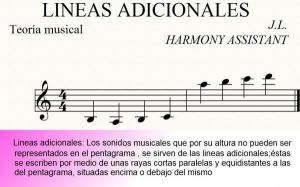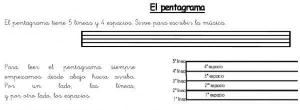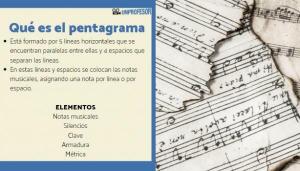What is the PENTAGRAM for
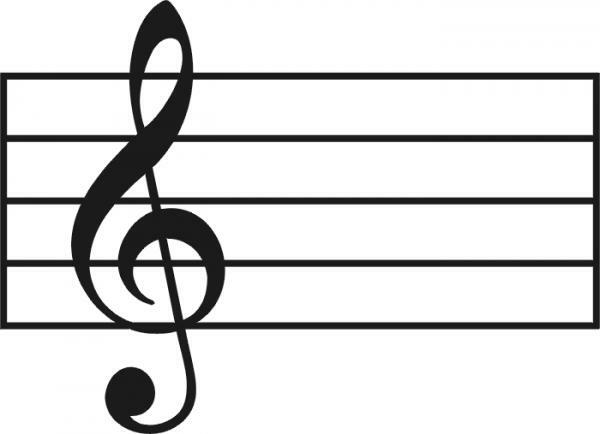
Image: Music Theory
The purpose of language is communication, each language has a structure and a character system that help us understand a language and be able to share it with someone else, that this person has the same understanding that we allow us to evolve and grow up. Music is no exception, since it is also a language that we must learn to read and write in order to fully enjoy and share it. Just as in a language we have lyrics, in music there are notes. In this lesson from a TEACHER we will learn about what is the pentagram for in writing and reading music.
If you want to know what the pentagram is for you have to know that it is a system of five equidistant lines, comes from the Greek "Penta" (which means 5) and "grama" (which means writing, drawing or line), where all the notes, symbols and indications necessary to be able to read music are written.
It is important to mention that both the lines and the spaces of the staff are used to place notes and each note is given a different name depending on its height on the staff.
The staff, also called the musical pattern, began to be used in the Middle Ages when a system was invented to be able to write and read Gregorian chant, a type of chant with a religious function that was performed by several people.
At first the Gregorian singing it was very simple and did not need the staff for the notes, in fact, it was a monodic song (it was sung mostly with a single note). Over time, Gregorian chant began to become more complex and the system was transformed so that the notes could be read more accurately.
First the "Tetragram" (tetra comes from the Greek and means 4), 4 lines instead of the 5 that we currently use. Over time, the system changed and, around the s. XVII, the pentagram was officially generalized and remained so until today, the staff she came to stay.
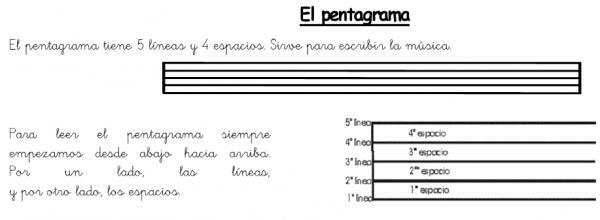
Image: Google Sites
As we mentioned earlier, on the staff we will place all the musical notes and necessary indications so that the music that is written in it is interpreted in the most precise way to the idea that inspired it. Just as in language, we call the understanding and / or interpretation of written music "reading", and it is read from left to right and from top to bottom (as it is a system of European origin).
Now that you know what the staff is for, we will discover the key elements that make it up and that will help us better understand its uses.
Staff lines and spaces
To refer to the lines we list them from bottom to top. In other words, the lowest line is the first line, and the highest line is the fifth line. The same thing happens with spaces.
Although most musical instruments require only one staff, there are instruments that allow more complexity, such as the piano, harp and marimba, which can be played with 2 hands or even more (there are 4-hand works for 2 people to play simultaneously).
There are also instruments such as the organ, where more than two staves are required. In these cases, the music of these instruments is written with two staves, placed in parallel and joined by a symbol called wrench. We call a set of staves like this system.
Musical notes on the staff
Then there are The musical notes. We know how to name a note and what pitch it will have depending on where it is on the staff. These can be placed on the lines and in the spaces. If a note is very serious, or very sharp, we resort to placing what we call additional lines. These are short lines that we only place when the note that needs them is lower than the first line or higher than the fifth line of the staff, and we place as many as necessary to write the note desired. It is important to remember that when we write additional lines, we also create additional spaces.
In order to recognize the name of the notes, there is another important element that is placed on the staff: the musical key. There are different musical keys and we recognize them depending on the symbol that is placed at the beginning of a measure. This symbol will indicate the name of the note of a specific line on the staff, from this, we can know the name of the rest of the notes.
The bars of the staff
And to finish with the definition of a staff, we will now address another important concept. Along with the notes, another element of equal importance that we find in the staff is the be quiet, which tells us that no note should be played, or that we should wait a certain number of measures. This brings us to the following concept: compasses.
The compass is a vertical division of the staff that indicates the beginning and the end of a musical part and that has a duration determined by the metrics. Graphically, the compass is indicated by a line (or several), which can have different thicknesses, repetitions or be accompanied by other signs, depending on what we want to indicate at the end of the compass. For example, the double line with a colon means repetition. Another example: the double line highlighted in bold indicates the end of a song, theme or musical work.
As we mentioned, the staff also places the metrics. These are numbers that are seen as fractions at the beginning of the staff, and they indicate the keystroke and the number of notes that can fit in a measure.

Image: Slideshare
The staff is the canvas of music. While we have mentioned the most important factors, there are many more elements and symbols that can be noted on a score. It is important to remember that everything this system has a purpose: that the music is interpreted in the most similar way to the idea of the composer.
From the essential elements, there will be small variations that depend on the personality and way of writing of the authors, however we can say that now that you know the definition of staff, you already know a new form of language universal.
I hope you have enjoyed this article and we invite you to give us your opinion to continue improving and contributing to learning.

